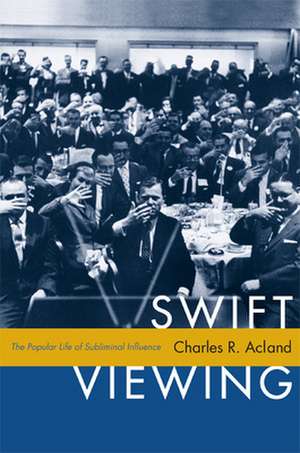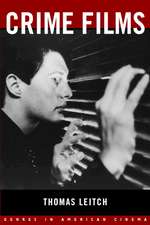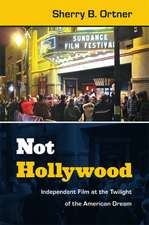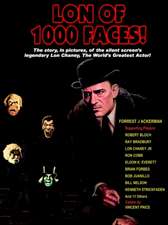Swift Viewing – The Popular Life of Subliminal Influence
Autor Charles R. Aclanden Limba Engleză Paperback – 2012
Preț: 264.26 lei
Nou
Puncte Express: 396
Preț estimativ în valută:
50.58€ • 54.96$ • 42.52£
50.58€ • 54.96$ • 42.52£
Carte tipărită la comandă
Livrare economică 21 aprilie-05 mai
Preluare comenzi: 021 569.72.76
Specificații
ISBN-13: 9780822349198
ISBN-10: 0822349191
Pagini: 328
Ilustrații: 58 illustrations, 1 table
Dimensiuni: 156 x 234 x 15 mm
Greutate: 0.45 kg
Editura: MD – Duke University Press
ISBN-10: 0822349191
Pagini: 328
Ilustrații: 58 illustrations, 1 table
Dimensiuni: 156 x 234 x 15 mm
Greutate: 0.45 kg
Editura: MD – Duke University Press
Recenzii
A comprehensive and compelling archaeology of the dream of invisible influence through media, this is a much-needed and frighteningly contemporary history. Fred Turner, author of From Counterculture to Cyberculture: Stewart Brand, the Whole Earth Network, and the Rise of Digital Utopianism
Making an important intervention in media and cultural history, Charles R. Acland examines how a seemingly fringe technological practice became a lightning rod for public anxiety about the power of the media. As he argues, the idea of subliminal influence is still very much with us. It may have been scientifically refuted, but it is clearly of continuing relevance in popular suspicions about the relationship between media, information, and consciousness. Jeffrey Sconce, author of Haunted Media: Electronic Presence from Telegraphy to Television
"Its a sober book covering an occasionally weird stretch of cultural territory. Acland, a professor of communication studies at Concordia University, in Montreal, calls the concept of subliminal influence a form of vernacular cultural critique. It operates in a zone lying somewhere between social science and urban legend. And the belief is a hardy one. Over the years, public-opinion surveys in the United States have found that between 50 and 70 percent of respondents think that advertisers used subliminal techniques, with comparably high levels of belief in their effectiveness." Scott McLemee, Inside Higher Ed, February 15th 2012
"A comprehensive and compelling archaeology of the dream of invisible influence through media, this is a much-needed and frighteningly contemporary history." Fred Turner, author of From Counterculture to Cyberculture: Stewart Brand, the Whole Earth Network, and the Rise of Digital Utopianism "Making an important intervention in media and cultural history, Charles R. Acland examines how a seemingly 'fringe' technological practice became a lightning rod for public anxiety about the power of the media. As he argues, the idea of subliminal influence is still very much with us. It may have been scientifically refuted, but it is clearly of continuing relevance in popular suspicions about the relationship between media, information, and consciousness." Jeffrey Sconce, author of Haunted Media: Electronic Presence from Telegraphy to Television "It's a sober book covering an occasionally weird stretch of cultural territory. Acland, a professor of communication studies at Concordia University, in Montreal, calls the concept of subliminal influence a form of "vernacular cultural critique." It operates in a zone lying somewhere between social science and urban legend. And the belief is a hardy one. Over the years, public-opinion surveys in the United States have found that between 50 and 70 percent of respondents think that advertisers used subliminal techniques, with comparably high levels of belief in their effectiveness." Scott McLemee, Inside Higher Ed, February 15th 2012
Making an important intervention in media and cultural history, Charles R. Acland examines how a seemingly fringe technological practice became a lightning rod for public anxiety about the power of the media. As he argues, the idea of subliminal influence is still very much with us. It may have been scientifically refuted, but it is clearly of continuing relevance in popular suspicions about the relationship between media, information, and consciousness. Jeffrey Sconce, author of Haunted Media: Electronic Presence from Telegraphy to Television
"Its a sober book covering an occasionally weird stretch of cultural territory. Acland, a professor of communication studies at Concordia University, in Montreal, calls the concept of subliminal influence a form of vernacular cultural critique. It operates in a zone lying somewhere between social science and urban legend. And the belief is a hardy one. Over the years, public-opinion surveys in the United States have found that between 50 and 70 percent of respondents think that advertisers used subliminal techniques, with comparably high levels of belief in their effectiveness." Scott McLemee, Inside Higher Ed, February 15th 2012
"A comprehensive and compelling archaeology of the dream of invisible influence through media, this is a much-needed and frighteningly contemporary history." Fred Turner, author of From Counterculture to Cyberculture: Stewart Brand, the Whole Earth Network, and the Rise of Digital Utopianism "Making an important intervention in media and cultural history, Charles R. Acland examines how a seemingly 'fringe' technological practice became a lightning rod for public anxiety about the power of the media. As he argues, the idea of subliminal influence is still very much with us. It may have been scientifically refuted, but it is clearly of continuing relevance in popular suspicions about the relationship between media, information, and consciousness." Jeffrey Sconce, author of Haunted Media: Electronic Presence from Telegraphy to Television "It's a sober book covering an occasionally weird stretch of cultural territory. Acland, a professor of communication studies at Concordia University, in Montreal, calls the concept of subliminal influence a form of "vernacular cultural critique." It operates in a zone lying somewhere between social science and urban legend. And the belief is a hardy one. Over the years, public-opinion surveys in the United States have found that between 50 and 70 percent of respondents think that advertisers used subliminal techniques, with comparably high levels of belief in their effectiveness." Scott McLemee, Inside Higher Ed, February 15th 2012
Notă biografică
Cuprins
Acknowledgments xi
List of Illustrations xiii
Prologue: Black Magic on Mars 1
1. Subliminal Communication as Vernacular Media Critique 13
2. Mind, Media, and Remote Control 43
3. The Swift View 65
4. Mind-Probing Ad-Men 91
5. Crossing the Popular Threshold 111
6. The Hidden and the Overload 133
7. From Mass Brainwashing to Rapid Mass Learning 165
8. Textual Strategies for Media Saturation 193
9. Critical Reasoning in a Cluttered Age 227
Notes 239
Bibliography 267
Index 291
List of Illustrations xiii
Prologue: Black Magic on Mars 1
1. Subliminal Communication as Vernacular Media Critique 13
2. Mind, Media, and Remote Control 43
3. The Swift View 65
4. Mind-Probing Ad-Men 91
5. Crossing the Popular Threshold 111
6. The Hidden and the Overload 133
7. From Mass Brainwashing to Rapid Mass Learning 165
8. Textual Strategies for Media Saturation 193
9. Critical Reasoning in a Cluttered Age 227
Notes 239
Bibliography 267
Index 291
Descriere
Media theorist Acland looks back at the strange history of subliminal seduction: a theory first propagated in the late 1950s by marketing researcher James Vicary, who claimed that movie audiences bought more refreshments if advertising messages too quick to be noticed were inserted into movies. The study was soon proven false, but that hasnt kept the concept from having a long afterlife in the popular imagination. Acland traces the idea back to late 19th century fears about invisible influences on the masses and up through the work of Marshall McLuhan and Vance Packard. He argues that subliminal influence has persisted as a form of vernacular media criticism because of the way it expresses fears about the pace of media and technological change and the growth of consumer capitalism.
















